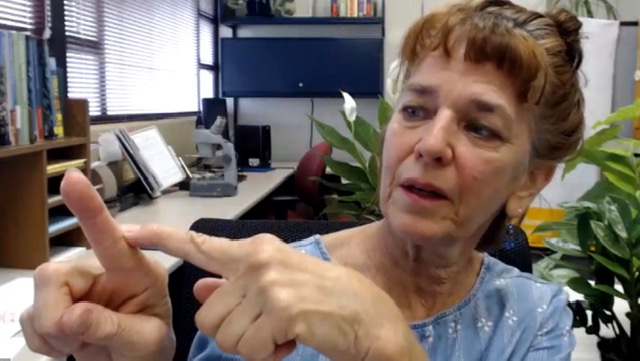
Master gardener Lori Ann Asmus offers tips in video

|
|
Lori Ann Asmus holds up her favorite tool for checking plant moisture: her finger.
(Screenshot from YouTube)
|
Even though the temperatures have improved, the air is smoky and the conditions rather depressing now for gardening. But thanks to the Sacramento County master gardeners, you can spend your gardening time learning how to brighten your indoor world with houseplants.
Lori Ann Asmus, who is a master gardener and interior landscaper, presented a terrific webinar on houseplants during Virtual Harvest Day earlier this month. It was taped for later viewing on YouTube, and I highly recommend it. (Full disclosure: I'm a rookie when it comes to houseplants, so most of her session was new to me.)
There's one caveat on the YouTube videos: Instead of being broken up by topic, all of Harvest Day 2021 is on one big video -- 4.5 hours' worth. It's hard to search for an individual topic or webinar. But I know how to get you to the houseplant sequence:
Go to YouTube here: https://www.youtube.com/watch?v=weLb6CTVZ9c
Then click on "Show More" under the brief description and the Farmer Fred link. (Fred's good, too, but we want houseplants today.)
Lori Ann Asmus is the second-to-last webinar listed. Click on her time and you'll pop into moderator Julie Oliver's introduction of Asmus.
Asmus conducted the entire webinar from the UCCE office, but she covers a lot of ground and has examples. The session runs about half an hour. Have a pen and paper handy to take notes!
And let's all hope they get the fires under control soon and we have better outdoor gardening conditions.
-- Kathy Morrison
Comments
0 comments have been posted.Sacramento Digs Gardening to your inbox.
Sites We Like
Garden Checklist for week of July 21
Your garden needs you!
* Keep your vegetable garden watered, mulched and weeded. Water before 8 a.m. to reduce the chance of fungal infection and to conserve moisture.
* Feed vegetable plants bone meal, rock phosphate or other fertilizers high in phosphate to stimulate more blooms and fruiting. (But wait until daily high temperatures drop out of the 100s.)
* Don’t let tomatoes wilt or dry out completely. Give tomatoes a deep watering two to three times a week.
* Harvest vegetables promptly to encourage plants to produce more. Squash especially tends to grow rapidly in hot weather. Keep an eye on zucchini.
* Pinch back chrysanthemums for bushy plants and more flowers in September.
* Remove spent flowers from roses, daylilies and other bloomers as they finish flowering.
* Pinch off blooms from basil so the plant will grow more leaves.
* Cut back lavender after flowering to promote a second bloom.
* It's not too late to add a splash of color. Plant petunias, snapdragons, zinnias and marigolds.
* From seed, plant corn, pumpkins, radishes, winter squash and sunflowers.